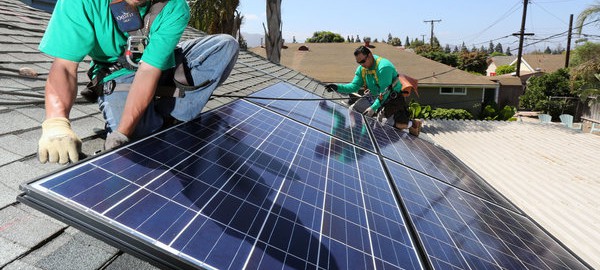The big idea right now for solar and batteries is this: put solar panels on your roof, a battery in the backyard (or basement), and become utterly independent from the power grid, using free electricity from the sun. Batteries have long been looked to as a way to store energy solar energy during the day to be used at night, but they have long been too expensive to be used widely. But many companies are looking at 2015 as a very important year for the solar and battery partnership and I’ve heard the word “tipping point” being used repeatedly about this intersection recently.
Why all the excitement and why now? First off, traditional lithium-ion batteries — the kind being widely used in cell phones and laptops — are becoming cheaper than ever before. Electric car company Tesla and Japanese battery giant Panasonic have been working closely on lowering costs of their lithium-ion batteries significantly, and with Tesla’s “gigafactory” the companies expect to be able to reduce the lithium-ion battery cost by another third.
Navigant Research estimates that Tesla pays about $200 per kWh for its Panasonic battery cells today, and that price could drop as low as $130 per kWh by 2020 when Tesla’s massive factory — which is expected to more than double the world’s lithium-ion battery production — is fully up and running in Nevada. Several years ago, lithium-ion batteries cost closer to $1,000 per kWh. Tesla plans to sell some of the batteries from its factory into the power grid market, and SolarCity (the installer company chaired by Tesla CEO Elon Musk) already uses Tesla batteries for a solar panel energy storage system.
Lithium ion batteries are becoming such a clear low cost platform for energy storage that other startups beyond Tesla are adopting this idea, too. At CES last week, a startup called Gogoro launched an electric scooter and battery swapping infrastructure based around modular lithium ion batteries designed also in conjunction with Panasonic. Owners of the Gogoro scooter will some day be able to swap out their two depleted batteries at a nearby battery swap station, and they will likely pay a subscription for access to the batteries.
But it’s not just the economics of lithium ion batteries that are driving the pairing of solar and batteries. Other startups have been developing newer, low-cost battery chemistries that are optimized for the power grid, like Aquion Energy and Ambri. Aquion Energy last week announced that one of its largest battery installations to date (2 MWh) is going into a solar system on the Kona coast of Hawaii.
The surge in solar panel installations is one of the main drivers behind this grid battery trend. There’s a lot bigger market these days for solar: More than a third of all new electricity installed in the U.S. in the first three quarters of 2014 came from solar panels, both utility-scale solar and solar panels on residential rooftops. That’s second only to new natural gas plants.
Solar companies, like SunPower, SolarCity, Sunrun and others, are doing deals with battery makers, looking to offer new services. Startup Stem, which uses distributed battery packs to work like virtual power plants, is working with Kyocera Solar.
Then there’s the grid battery market that’s being opened up by the state of California’s aggressive mandates for energy storage. California utilities are being asked to buy 1,325 megawatts of energy storage services by 2020, and utility Southern California Edison has already said it will buy 250 MW of energy storage systems. Part of SCE’s plans will be made up by a huge 100 MW battery plant from AES Energy Storage and a 85 MW contract from Stem.
So clearly, utilities aren’t worried about energy storage in general, because they will some day be major users of this technology. But in the short term, some are worried about so-called grid defections. If your solar panels and battery offer you all the electricity options you need, why do you need the utility?
However, according to a recent report from Moody’s, batteries and clean power are just still too expensive to be too threatening right now. Moody’s said that even with battery prices at $200 per kWh, and solar panels at $3.50 per watt, these technologies are “an order of magnitude too expensive to substitute for grid power.” Battery prices would have to be closer to $10 per kWh to $30 per kWh range to be cost competitive widely for the power grid, said Moody’s.
Those costs might be difficult for (most) residential customers to justify, but it could be a different story for commercial building owners. GTM Research says the market for solar panels paired with batteries will surpass $1 billion in annual revenue by 2018 (up from just $42 million last year), with collectively 318 MW of solar and storage capacity installed in the U.S. by that time. One in ten new commercial solar customers will opt for an energy storage addition by 2018, predicts GTM Research.
Source: Gigaom
